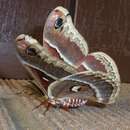en
names in breadcrumbs


Hyalophora gloveri is a large moth with a wingspan of about 10 cm. They have reddish-brown and grey forewings marked with a small eyespot, thick white bands, and white discal spots. Hyalophora gloveri possess large, quadripectinate (elaborate, featherlike) antennae on the tops of their heads. They have a large abdomen, striped white and rufous (reddish-brown). The head and thorax are rufous as well, with a white collar on the thorax to divide the two. The rufous color extends across the proximal and median areas of their forewings. There are obvious thick white antemedial and postmedial bands, both bordered by black on the sides within the median area. The moth also has a small, ovaline discal spot located on the median part of its forewing that is cream and orange with a black border; as well as a large crescent shaped one on the hindwing. The subterminal part of their wings is a light, powdery grey, containing a small black and blue eyespot that is located on the apex (top outer corner) of their forewing. A slight blushing of pink and purple is found right above this. The subterminal line is a scalloped, cream-colored edge that looks not unlike aged lace. The wing margins (outer edge) are bordered by a cream-colored line.
Adult Hyalophora gloveri moths emerge in the pre-dawn hours of late May to early June (Roberts, et al. 2014), the males emerging a few days before the females (Tuskes, et al. 1996). The adults have atrophied mouthparts but are able to sustain themselves for 6-7 days on the energy they created as voracious caterpillars. The females release pheromones which the males are able to detect over great distances thanks to sensilla (hair-like sensory structures) on their large antennae. The females are usually found and mated on their first night of emergence and begin laying eggs (ovipositing) on their preferred host plant. They lay the bulk of their eggs on the first night they mate, but will lay more on subsequent nights as well. Females have a large abdomen, containing on average 155 eggs (Miller, 1978); about 103 of which will hatch within two weeks of being laid (Miller, 1978), ready to start the cycle again.